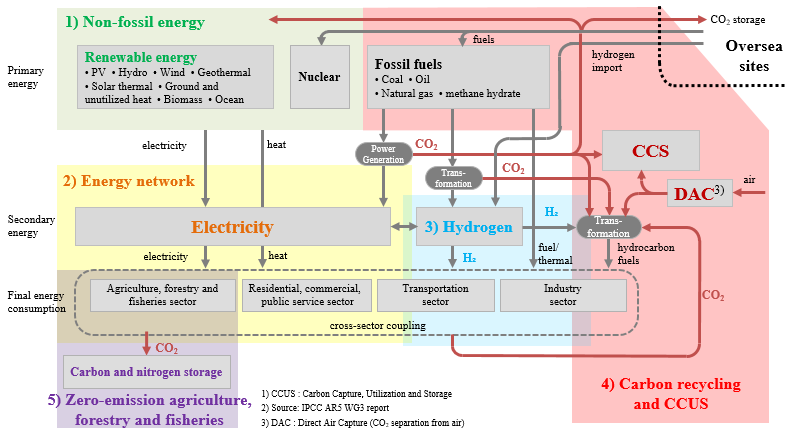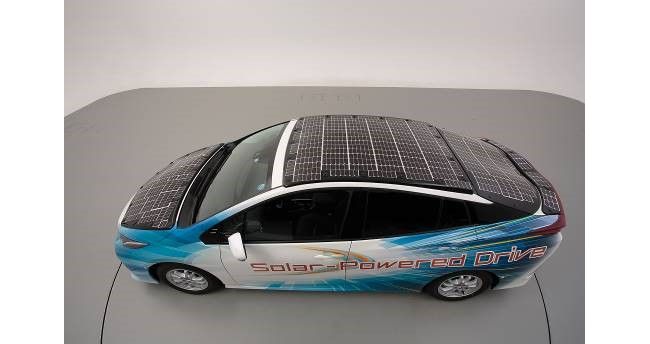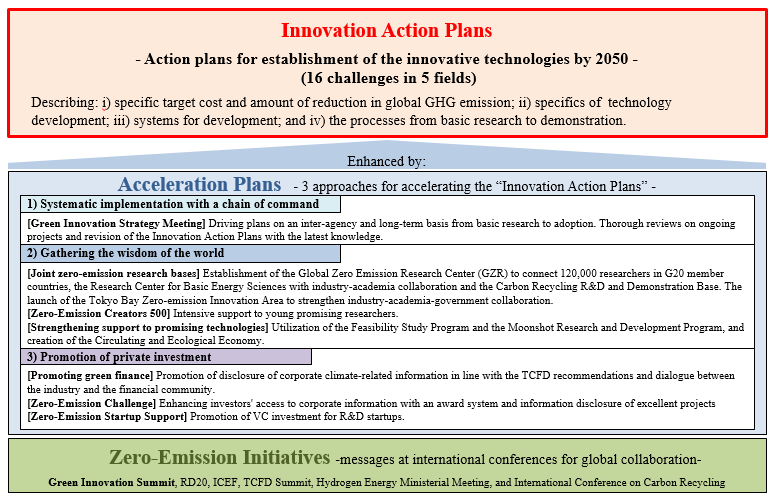Innovation toward “beyond zero” CO2 emissions
(in provisional translation)
(English ver.) 2020-12-09
 (Picture upper left) Provided by Sekisui Chemical Co., Ltd.
(Picture upper left) Provided by Sekisui Chemical Co., Ltd.
The Paris Agreement, a framework for tackling climate change from 2020, requires all signatory countries to take action for reducing greenhouse gas emissions. In order to achieve the reduction target, it is necessary to reduce costs related to various environmental technologies through innovation. This article presents cutting-edge technologies currently under development as well as efforts made by the Japanese government to provide support measures.
Challenge toward breakthrough technologies to reduce CO2 emitted even in the past
It is necessary to invest in various types of environmental technologies in order to achieve the reduction targets set by the Paris Agreement. A computer model created by the Research Institute of Innovative Technology for the Earth (RITE) estimates necessary additional expenditures to be as much as 7 trillion dollars per annum worldwide. Therefore, the substantial reduction of costs associated with environmental technologies is essential so that those technologies can be practically implemented in a society.
For example, solar batteries used for photovoltaic generation were under progressive development for more than 30 years since 1974 under the strategies led by an initiative known as the “Sunshine Project”. As a result, the technological innovation led to a tremendous cost reduction, in turn bringing about the dissemination of solar batteries, the current cost being less than one-250th of the original level.
The “Strategy for breakthrough Environmental Innovation” to support leading-edge R&D
As seen in the development of solar batteries, the development of breakthrough technologies cannot be accomplished from a short-term viewpoint or by efforts made only by limited participants.
Japan set forth the “Strategy for Breakthrough Environmental Innovation” on January 21, 2020 in order to promote technological development in the fields of energy and environment. This strategy aims to establish breakthrough technologies which will realize a carbon-neutral world and even reduce the amount of CO2 emitted in the past, a technology referred to as “beyond zero”, by 2050.
The “Strategy for Breakthrough Environmental Innovation” is comprised of 3 pillars, namely the “Innovation Action Plan” setting goals for R&D, the “Acceleration Plan” pushing it forward toward realization and the “Zero Emission Initiatives”.
The “Innovation Action Plan” selected 16 challenges in 5 fields as well as 39 development themes to which Japan’s technology is expected to contribute. Each theme stipulates the target cost for practical implementation and expected reduction of greenhouse gas emissions when it is implemented together with the implementation systems and steps of R&D.
The technologies stipulated by the “Innovation Action Plan” can be categorized into 5 key areas.
Energy generated by “non-fossil fuel sources” (1) emitting no CO2 such as solar power and wind power is distributed to businesses and homes through the energy network (2). Hydrogen (3), among those non-fossil fuel sources, can not only be used as energy, but also be utilized in the industrial sectors for the production of daily necessities. On the other hand, the production and utilization of energy including electric power generation and heat utilization by fossil fuels such as oil and coal emit a substantial amount of CO2. It is important to capture, utilize and store CO2 emitted from industrial sectors by carbon recycling and CCUS (4). Additionally, agriculture, forestry and fisheries, by utilizing relevant ecosystems (5), are expected to absorb CO2.
- Five Key Areas
- 1) Non-fossil fuel energy
Non-fossil fuel energy is to be promoted in all sectors through hydrogen utilization and carbon recycling, in addition to supplying electricity.
2) Energy network
For the mass-introduction of renewable energy, batteries are to be utilized for storage. The integration of power systems and the optimization of a supply/demand balance are also to be pursued.
3) Hydrogen
CO2-free hydrogen produced by renewables is to be utilized in a variety of sectors such as transportation, industries and power generation.
4) Carbon recycling, CCUS (Carbon Capture, Utilization and Storage)
These measures are expected to reduce CO2 emissions substantially.
5) Zero emission agriculture, forestry and fisheries
Ecosystems are to be utilized to absorb CO2.

<Reference: Key Areas of the Innovation Action Plan>
Some examples of innovative technologies under development are outlined below:
Photovoltaic power generation everywhere
Conventional photovoltaic power generation is restricted by site availability. New materials such as perovskite together with new structures such as tandem and quantum dots are now gaining attention. Photovoltaic power generation equipment using these materials and structures are as thin, light and flexible as fabric. They can be installed on the roofs of factories or on the external walls of buildings. They can also be utilized on moving objects like automobiles. Higher power generating efficiency is expected for these types of photovoltaics than the conventional one.

(Picture shown on the website of Toyota Motor Corporation)
Steelmaking utilizing CO2-free hydrogen
In the current steel making process, iron ore is reduced through chemical reaction with carbon. Oxygen contained in iron ore is combined with carbon in this process, which emits a large amount of CO2. A new method of reduction is currently under consideration whereby hydrogen derived from renewables is used instead of carbon. This will make it feasible to produce “zero-carbon steel” emitting no CO2 in the manufacturing process.
CO2 solidified into concrete
Cement, a major material of concrete, contributes to resource circulation because it uses a large amount of waste materials. On the other hand, cement production emits a considerable amount of CO2 through calcination. If the CO2 is separated and then absorbed by waste concrete, it can be used as a resource for cement production. The CO2 can also be absorbed and solidified in concrete through its production process. Efforts are being made in some sectors toward practical implementation of this technology. Buildings such as schools and hospitals may be constructed with this type of concrete in the future.
Artificial photosynthesis
Artificial photosynthesis is a technology, imitating photosynthesis by vegetation, which creates organic matter (starch) and oxygen from CO2 and water by photovoltaic energy. With this technology, chemical products can be synthesized from CO2 and water as raw materials utilizing photovoltaic energy. Research and development is underway toward the realization of artificial photosynthesis focusing on “photocatalysts”, “separation membranes” and “synthetic catalysts”. If this technology is realized, plastics and synthetic fibers can be produced from CO2.
Removing CO2 directly from the atmosphere
This is a technology to directly remove CO2 from the atmosphere, referred to as DAC (Direct Air Capture). Special absorbents and filters are to be used to separate and collect low-concentration CO2 contained in the atmosphere. To make this technology feasible, it is necessary to develop new separation membranes or chemical absorbents. Furthermore, technological development is essential for utilization or solidification of collected CO2.
Bio jet fuel produced from CO2 as a raw material
A technology is under development to produce fuels such as jet fuel by cultivating microalgae that absorb CO2. A demonstration experiment is currently underway toward a mass-production of such microalgae in a stable manner aiming to realize commercial flights using bio jet fuel by 2030. You may be traveling on a zero-emission aircraft sometime in the future.
Zero-emission agriculture, forestry and fishery
In the fields of agriculture, forestry and fishery, technologies are under development to reduce CO2 emissions by utilizing farmland, forests and marine ecosystems. Some examples of such technologies are creating new varieties of vegetation such as a “fast-growing wood” by biotechnology, and utilizing biomass materials to produce industrial products. Additionally, cutting-edge technologies are under development to cultivate marine algae toward the realization of the “Blue Carbon” Initiative whereby carbon separated from CO2 can be accumulated in marine ecosystems. New types of rice and cattle emitting less methane (a gas which has more greenhouse effects than CO2) as a decomposed gas and as belches respectively , are being developed.
Acceleration plan
In order for the development of those technologies based on the “Innovation Action Plan” not to remain on the desktop, it is essential to work out who is to lead R&D and how. It is also important to develop mechanisms whereby those technologies can be assessed in the relevant markets. The “Acceleration Plan”, comprised of the following three pillars, has been set to push forward the “Innovation Action Plan”.
(1) Planned acceleration by a command post
To steadily implement the strategies, the “Committee for the Strategic Promotion of Green Innovation” has been inaugurated comprising experts. It organizes the collaboration among related ministries and agencies to review the past projects and to consider the potential of innovative technologies. It also aims to maximize the effects of its strategies by discussing challenges with private enterprises concerned toward political support measures and the practical implementation of such technologies
(2) Accumulation of wisdom from home and abroad
The Global Zero Emission Research Center established in January 2020 and other organizations are to promote R&D bringing together wisdom from home and abroad. Additionally, support measures for innovative technologies are to be enhanced through programs such as “Zero Emission Creators 500”, a support program for young and talented researchers.
(3) Attracting private investment
To practically implement innovative technologies in a society, it is essential to encourage private enterprises to increase investment in such technologies. Japan aims to achieve the “virtuous cycle of environment and growth”. To this end, “green finance” is to be promoted through corporate information disclosures based on the TCDF* recommendations. Additionally, mechanisms to assess climate related efforts will be put in place. Support measures for related ventures will also be organized in order to encourage private investment.
*TCDF: the Taskforce on Climate-related Financial Disclosures
The “Zero Emission Initiatives” will dispatch the latest information on technological developments through international conferences and other meetings to be held in Japan aiming to share common objectives. Such conferences include the Green Innovation Summit, the Hydrogen Energy Ministerial Meeting and the International Industry-Academia-Government Conference on Carbon Recycling.
Japan plans to use its technological strengths to bring about innovation and also realize the earliest implementation of such technologies in society, which will contribute to the reduction of global greenhouse gas emissions.
Division in charge
About the article
Energy and Environment Innovation Strategy Office, Industrial Science and Technology Policy and Environment Bureau
About Special Contents
Research and Public Relations Office, Policy Planning and Coordination Division, Commissioner's Secretariat
![]() The original Japanese text of this article; Click here
The original Japanese text of this article; Click here
